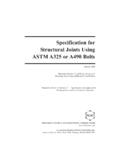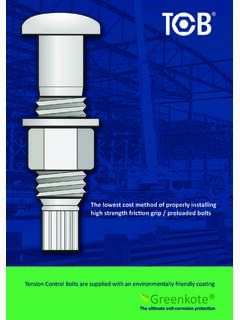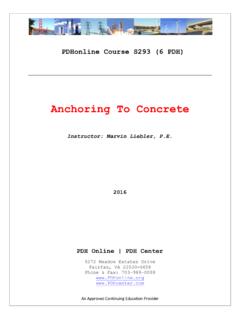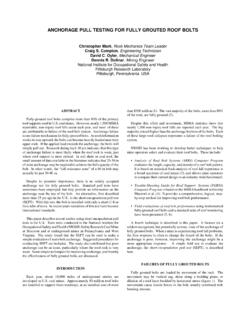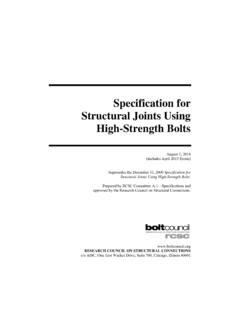Transcription of Design of Bolts in Shear-Bearing Connections per AISC LRFD ...
1 PDHonline Course S134 (3 PDH) Design of Bolts in Shear-BearingConnections per AISC LRFD 3rdEdition (2001)2012 Instructor: Jose-Miguel Albaine, , Online | PDH Center5272 Meadow Estates DriveFairfax, VA 22030-6658 Phone & Fax: Approved Continuing Education ProviderPage 1 of 18 Design of Bolts in Shear-Bearing Connections per AISC LRFD 3rd Edition (2001) Jose-Miguel Albaine, , Course Content A) Bolted Connections 1. Introduction Failure of structural members is not common, but most structural failures are caused by poorly designed or detailed Connections .
2 In times past, the pin device most often used was the rivet. Since the 1950 s, the high-strength Bolts have substituted the rivet as the primary connector for structural steel connection. This course will address the Design of high-strength Bolts in a shear bearing-type connection. This type of connection is used in a variety of steel assemblage applications such as truss joints for bridges, buildings, and transmission towers, beam and column splices, wind bracing systems, and built-up sections. For a detail discussion of Design of riveted connection the reader can refer to other sources (Ref.)
3 1). A great number of types and sizes of bolt are available, and so are many Connections in which they are used. We will cover a few of the most common bolting methods used in building structures. It is convenient to categorize the behavior of different types of Connections according to the type of loading. The tension member lap splice shown on Figure 1 produces forces that tend to shear the shank of the fastener. The hanger connection shown on Figure 2 subjects the fastener to tension . The connection shown in Figure 3 subjects the upper row of fasteners to both shear and tension .
4 The strength of a fastener depends on whether it is stressed in shear or tension , or both. Figure 1 Figure 2 Figure 3 Page 2 of 18 The LRFD provides updated bolting information consistent with the 2000 Research Council of Structural Connections (RCSC) specifications. The Design philosophy of Load and Resistance Factor Design (LRFD) is primarily based on a consideration of failure conditions rather than working load conditions. Load factors are applied to the service loads, and members are selected with enough strength to resist the factored loads.
5 Furthermore, the theoretical strength of the element is reduced by the application of a resistance factor. The equation format for the LRFD method is stated as: iQi = Rn (Eq. 1) Where: Qi = a load (force or moment) i = a load factor (LRFD section A4 Part 16, Specification) Rn = the nominal resistance, or strength, of the component under consideration = resistance factor (for Bolts given in LRFD Chapter J, Part 16) The LRFD manual also provides extensive information and Design tables for the Design considerations of Bolts in Part 7, Part 9, 10 and Part 16 Chapter J.
6 Other parts of the manual cover more complex Connections such as flexible moment Connections (Part11), fully restrained moment Connections (Part 12), bracing and truss Connections (Part 13), column splices (Part 14), hanger Connections , bracket plates, and crane-rail Connections (Part 15). Our discussion will be limited to the basic shear bearing-type joints as presented in Part 7 and Part 16, Chapter J. 2. Failure Modes of Bolted Shear Connections There are two broad categories of failure in Connections with fasteners subjected to shear: failure of the fastener and failure of the parts being connected.
7 The basic assumption is that equal size fasteners transfer an equal share of the load as long as the fasteners are arranged symmetrically with Page 3 of 18respect the centroidal axes of the connected members. In a lap joint as shown in Figure 4, failure of the fastener is assumed to occur as shown. This connection has only one shear plane of action, thus the bolt it s said to be in single shear, and although the loading is not perfectly concentric, the eccentricity is small and usually is neglected. Figure 4 Figure 5 The connection in Figure 5 is similar, except that portions of the fastener shank is subject to half the total load, meaning that two cross sections are effective in resisting the total load.
8 The bolt for this condition is in double shear. Another failure mode for the bolt is that of bearing failure at the bolt hole as shown in Figure 6. Figure 6 Other modes of failure in shear Connections include failure of the members Page 4 of 18being connected and are categorized as: a) Failure resulting from excessive tension , shear, or bending in the parts being connected, tension members may fail by tension on both the gross area and effective net area. Block shear might also need to be investigated depending on the configuration of the connection (Figure 7).
9 Figure 7 Figure 8 Figure 9 b) Failure of the connected members due shear failure of plate (Figure 8), and large bearing exerted by the bolt (Figure 9). Other items affecting the bearing problem may be the presence of a nearby bolt or the proximity to an edge in the direction of the load. Therefore, the bolt spacing and edge distance will affect the bearing strength of a connection. TensionShearBlock ShearPage 5 of 183. Most Common Types of Fasteners in Structural Joints a) High-Strength Bolts : The three basic types of high strength listed in the LRFD are: ASTM designations A325, F1852, and A-490.
10 The new ASTM specification F1852 refers to the fasteners frequently referred to as tension control , TC, twist-off, or torque-and-snap fasteners. High-Strength Bolts range in diameter from to 1 in. For Bolts larger than 1 in the AISC allows the use of ASTM A449 provided that they are not used in slip-critical Connections . b) Unfinished Bolts These Bolts are made from low-carbon steel, designated as ASTM A307, and are available with both hex and square heads in diameters from to 4 in. in grade A for general applications.










